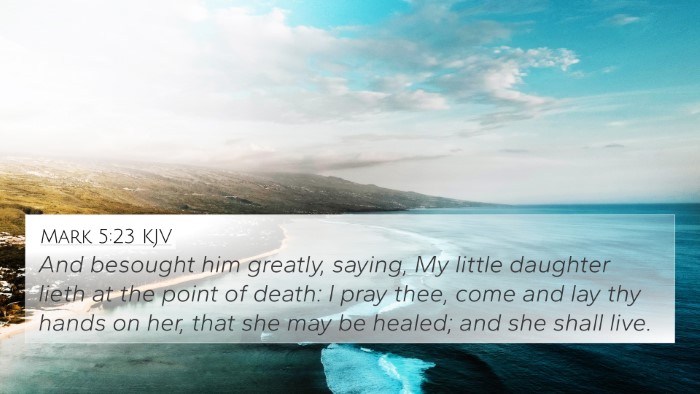Understanding Mark 1:30
Mark 1:30: "But Simon's wife's mother lay sick of a fever, and anon they tell him of her."
Overview of the Verse
This verse presents a situation in which Jesus is informed about the illness of Simon Peter's mother-in-law. It highlights both the human aspect of the disciples and the divine compassion that Jesus is about to demonstrate.
Summary of Commentaries
This section combines insights from renowned public domain commentaries to deepen our understanding of Mark 1:30.
Matthew Henry’s Commentary
Matthew Henry emphasizes the familial concern shown by the disciples. The sickness of Simon’s mother-in-law signifies the universal reality of illness and suffering in human life. The verse sets the stage for Jesus' healing ministry, illustrating His willingness to engage with personal needs, showing His ability to bring relief and restoration.
Albert Barnes’ Notes
Albert Barnes notes that the mention of Simon Peter's wife’s mother is significant for understanding the communal and family-oriented nature of the early disciples. He points out the immediacy of their report to Jesus, indicating a growing faith in His healing powers. This moment marks the beginning of many miraculous acts that define Jesus' earthly ministry.
Adam Clarke’s Commentary
Adam Clarke offers insights into the cultural context, noting the importance of women in the household and their roles. He highlights the seriousness of the fever and emphasizes the responsiveness of those present as they bring the need to Jesus. He suggests that this act of seeking Jesus reflects their belief in His authority and power.
Bible Cross-References
Mark 1:30 can be connected to several other scriptures that explore themes of healing, compassion, and discipleship. Here are some key cross-references:
- Matthew 8:14-15: Similar healing of Peter's mother-in-law, emphasizing Jesus' authority over sickness.
- Luke 4:38-39: A parallel account detailing the same event, showcasing the consistency in the Gospels.
- James 5:14: Discusses the anointing of the sick, linking community and divine intervention in healing.
- Mark 16:17-18: Illustrates the signs accompanying believers, including healing, which reflects the power given to the followers of Christ.
- Matthew 9:35: "And Jesus went about all the cities and villages... healing every sickness and every disease," which sets the context for His healing ministry.
- Luke 5:12-13: The healing of a leper emphasizes Jesus’ willingness to heal and His compassionate nature.
- Matthew 14:14: Jesus' compassion on the multitudes when He healed their sick, reinforcing the merciful aspect of His ministry.
- Mark 2:17: Jesus remarks that He came to call sinners, demonstrating His mission to heal not just physically, but spiritually.
- John 10:10: "I have come that they may have life, and have it to the full," suggests the holistic healing that Jesus embodies.
Thematic Connections
The verse and its cross-references reveal a rich tapestry of themes concerning healing, the nature of Jesus’ ministry, and the relationships between His followers. Here are some thematic connections derived from inter-Biblical dialogue:
- Compassion and Healing: Consistent depiction of Jesus as one who empathizes with human suffering. Each cross-reference reinforces Jesus’ role as a healer.
- The Role of the Community: Highlighted in both Mark 1:30 and its counterparts, where community members seek out Jesus, embodying faith as a collective action.
- Faith in Action: The immediate response of the disciples illustrates a model for faith that prompts action—seeking Jesus in times of need.
- Divine Authority: The authority of Jesus over health, illness, and even death connects across various books, showcasing His divine identity.
Conclusion
Mark 1:30 serves as a powerful reminder of the human condition and the compassionate response of Jesus to suffering. The insights from public domain commentaries combined with the connections through cross-referenzing biblical texts provide a comprehensive understanding of this verse. By exploring its broader theological implications, one can appreciate the depth of Jesus' ministry and the significance of communal faith in seeking divine intervention.
For those interested in deeper studies, utilizing a Bible concordance or a Bible cross-reference guide can enhance your understanding of how various scriptures interlink and support each other, enriching your overall biblical scholarship.






